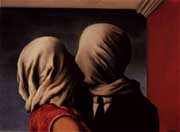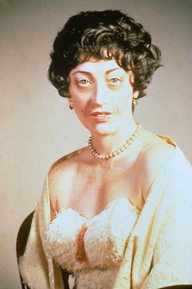Where one body (in the West, the white, youthful, able, male body) takes on the function of model or ideal, the human body, for all other types of body, its domination may be undermined through a defiant affirmation of a multiplicity, a field of differences, of other kinds of bodies and subjectivities.
Elizabeth Grosz, Volatile Bodies, Toward a Corporeal Feminism

Theoretically with this project we are focusing on the theories of Jacques Lacan and the notion that identity is not fixed and not pre-determined, but is fragmented, split, and determined by language and the Symbolic Order.
Julia Kristeva
follows Lacan with her ideas of the "Speaking Subject", as opposed to the "self". You are a subject, as opposed to a self, designated as being fully aware of your own intentions, guided by your own intellect; master of your own being, "subject" to no one, but to all sorts of phenomena including language, culture, nature, etc.... these phenomena influence how you come to be, as you are forever in a process of becoming. You are not aware of all that influences you, rather some influences are subliminal, forgotten, repressed, embedded within your subjecthood. Your identity is formed by some things that you are not aware of, for the realm of the unconscious -of The Real- is inaccessible to you.... they emerge semiotically, in signs and codes of your own making, finding their way into language, always ambiguously.
To live is to be in a constant state of flux.
Push aside the notion of "the self" for a Subject influenced by shaping processes, such as the unconscious and social forces.
According to psychoanalytic theory, there is no innate, unassailable self, but rather a subject who is always subject to desire, to want what cannot be had, what is impossible for civilized speaking beings. The Symbolic is a substitute for the things we cannot attain, though language has us ceaselessly try. The Symbolic realm of signs constitutes the subject.
Professor Aleksander Boskovic's lecture: "Ourselves as Others"
http://www.gape.org/sasa/lecture204.htm
Feminist Perspectives
of the Self:
http://www.science.uva.nl/~seop/archives/sum2000/entries/feminism-self/
"Addenda? Contemporary Cyborgs
and the Mediation of Embodiment" by Petra Kuppers
http://people.brunel.ac.uk/bst/1no1/PETRAkuppers.htm
"Identity in Cyberspace" by Marshall Soules, PhD:
http://www.mala.bc.ca/~soules/media113/netself.htm
"Engineering Cyborg Identitles" by N.Katherine Hayles:
http://www.altx.com/ebr/ebr1/hayles.htm
more cyberfeminism:
The Old Boys Network: "the mode is the message- the code is the collective! check out the projects:
http://www.obn.org/inhalt_index.html
The "Bitch Mutant Manifesto" by VNS Matrix:
http://www.aec.at/meme/symp/contrib/vns.html
GashGirl [doll yoko] Liquid_Nation:
http://www.sysx.org/gashgirl/
You need to explore the possibilities of identity in a post-industrial, postmodern culture where digital technology has created spaces for fluxuation, fluidity, and liberation.
Ideas to consider:
gender
materiality
image
authenticity
fluidity
Jacques Lacan:
Lacan reinterprets Freud in light of structuralist and post-structuralist theories, turning psychoanalysis from an essentially humanist philosophy or theory into a post-structuralist one.
One of the basic premises of humanism, as you recall, is that there is such a thing as a stable self, that has all those nice things like free will and self-determination. Freud's notion of the unconscious was one of the ideas that began to question, or to destabilize, that humanist ideal of the self; he was one of the precursors of post-structuralism in that regard. But Freud hoped that, by bringing the contents of the unconscious into consciousness, he could minimize repression and neurosis--he makes a famous declaration about the relation between the unconscious and conscious, saying that "Wo Es war, soll Ich werden": Where It was, shall I be." In other words, the "it," or "id" (unconscious) will be replaced by the "I", by consciousness and self-identity. Freud's goal was to strengthen the ego, the "I" self, the conscious/rational identity, so it would be more powerful than the unconscious.
For Lacan, this project is impossible. The ego can never take the place of the unconscious, or empty it out, or control it, because, for Lacan, the ego or "I" self is only an illusion, a product of the unconscious itself. In Lacanian psychoanalysis, the unconscious is the ground of all being.
Where Freud is interested in investigating how the polymorphously perverse child forms an unconscious and a superego and becomes a civilized and productive (as well as correctly heterosexual) adult, Lacan is interested in how the infant gets this illusion we call a "self." His essay on the Mirror Stage describes that process, showing how the infant forms an illusion of an ego, of a unified conscious self identified by the word "I."
http://www.colorado.edu/English/ENGL2012Klages/lacan.html
Requirements and AntiRequirements:
-No single sheet of paper/no single images
-Must be digital
-Must incorporate multimedia in its presentation
-Collages contained within a single image presentation are not acceptable
-No personal snapshots
Poststructuralism:
"While postmodernism's main tenet is that universal truth does not exist, poststructuralism "tends to stress the shifting, fragmented complexity of meaning (and relatedly of power), rather than a notion of its centralized order" (p. 91). Foucault asserts that universal assumptions and truths favor the dominant order. Poststructuralism extends from structuralism, which is heavily associated with Saussure, a Swiss linguist who theorized that underlying language is a formal structure, with a signified and a signifier, which can be studied (via semiotics) [Chandler, 2000].) Poststructuralists, however, discount the notion that language or "signifying practices" (and, by extension, meaning) has an innate, fixed structure. Poststructuralist theorists include Derrida, Foucault, Lacan, Kristeva and Barthes (Chandler, 2000)".
http://www.unc.edu/courses/2000fall/jomc245-001/poststructuralism.html
More Links:
Lacan-influenced video art exhibits:
http://www.ric.edu/bannister/2004/fw2004/OCT2004/Keijsers/ENGAGINGtext.html
http://www.elbabenitez.com/artistas/moraza/np_eng.html
http://www.findarticles.com/p/articles/mi_m1248/is_10_92/ai_n7576774
Quick & easy Lacnaian film theory by Judge Mike Pinsky: http://www.dvdverdict.com/columns/deepfocus/lacanianfilmtheory.shtml
"Posthuman Manifesto" by Robert Pepperell: http://garnet.acns.fsu.edu/%7Enr03/The%20Posthuman%20Manifesto.htm
"The Unreal Person: Portraiture
in the Digital Age":
http://strikingdistance.com/unreal/index.htm
"About Face: Photography and the Death of the Portrait":
http://www.hayward.org.uk/exhibitions/aboutface
Tina LaPorta's "Futurebody" flash website:
http://users.rcn.com/laporta.interport/futurebody.html
Aziz + Cucher's "Dystopia" series:
http://www.medienkunstnetz.de/works/maria/images/1/

the artist Orlan who changes her identity through plastic surgery, as well as using other mediums such as digital photography.:
http://www.orlan.net

Cindy Sherman images:
http://www.artnet.com/ag/fineartthumbnails.asp?aid=15454


Lacan's Mirror Stage:
Lacan says that at some point in this period, the baby will see itself in a mirror. It will look at its reflection, then look back at a real person--its mother, or some other person--then look again at the mirror image. The child moves "from insufficiency to anticipation" in this action; the mirror, and the moving back and forth from mirror image to other people, gives it a sense that it, too, is an integrated being, a whole person. The child, still unable to be whole, and hence separate from others (though it has this notion of separation), in the mirror stage begins to anticipate being whole. It moves from a "fragmented body" to an "orthopedic vision of its totality", to a vision of itself as whole and integrated, which is "orthopedic" because it serves as a crutch, a corrective instrument, an aid to help the child achieve the status of wholeness.
What the child anticipates is a sense of self as a unified separate whole; the child sees that it looks like what "others" look like. Eventually, this entity the child sees in the mirror, this whole being, will be a "self," the entity designated by the word "I." What is really happening, however, is an identification that is a MISRECOGNITION. The child sees an image in the mirror; it thinks, that image is "ME". But it's NOT the child; it's only an image. But another person (usually the mother) is there to reinforce the misrecognition. The baby looks in the mirror, and looks back at mother, and the mother says, "Yes, it's you!" She guarantees the "reality" of the connection between the child and its image, and the idea of the integrated whole body the child is seeing and identifying with.
The child takes that image in the mirror as the summation of its entire being, its "self." This process, of misrecognizing one's self in the image in the mirror, creates the EGO, the thing that says "I." In Lacan's terms, this misrecognition creates the "armor" of the subject, an illusion or misperception of wholeness, integration, and totality that surrounds and protects the fragmented body. To Lacan, ego, or self, or "I"dentity, is always on some level a FANTASY, an identification with an external image, and not an internal sense of separate whole identity.
This is why Lacan calls the phase of demand, and the mirror stage, the realm of the IMAGINARY. The idea of a self is created through an Imaginary identification with the image in the mirror. The realm of the Imaginary is where the alienated relation of self to its own image is created and maintained. The Imaginary is a realm of images, whether conscious or unconscious. It's prelinguistic, and preoedipal, but very much based in visual perception, or what Lacan calls specular imaging.
The mirror image, the whole person the baby mistakes as itself, is known in psychoanalytic terminology as an "ideal ego," a perfect whole self who has no insufficiency. This "ideal ego" becomes internalized; we build our sense of "self," our "I"dentity, by (mis)identifying with this ideal ego. By doing this, according to Lacan, we imagine a self that has no lack, no notion of absence or incompleteness. The fiction of the stable, whole, unified self that we see in the mirror becomes a compensation for having lost the original oneness with the mother's body. In short, according to Lacan, we lose our unity with the mother's body, the state of "nature," in order to enter culture, but we protect ourselves from the knowledge of that loss by misperceiving ourselves as not lacking anything--as being complete unto ourselves.
Lacan says that the child's self-concept (its ego or "I"dentity) will never match up to its own being. Its IMAGO in the mirror is both smaller and more stable than the child, and is always "other" than the child--something outside it. The child, for the rest of its life, will misrecognize its self as "other, as the image in the mirror that provides an illusion of self and of mastery.
Mirror Stage material written by Dr.Mary Klage, Associate
Professor of English at the University of Colorado at Boulder:
http://www.colorado.edu/English/ENGL2012Klages/lacan.html